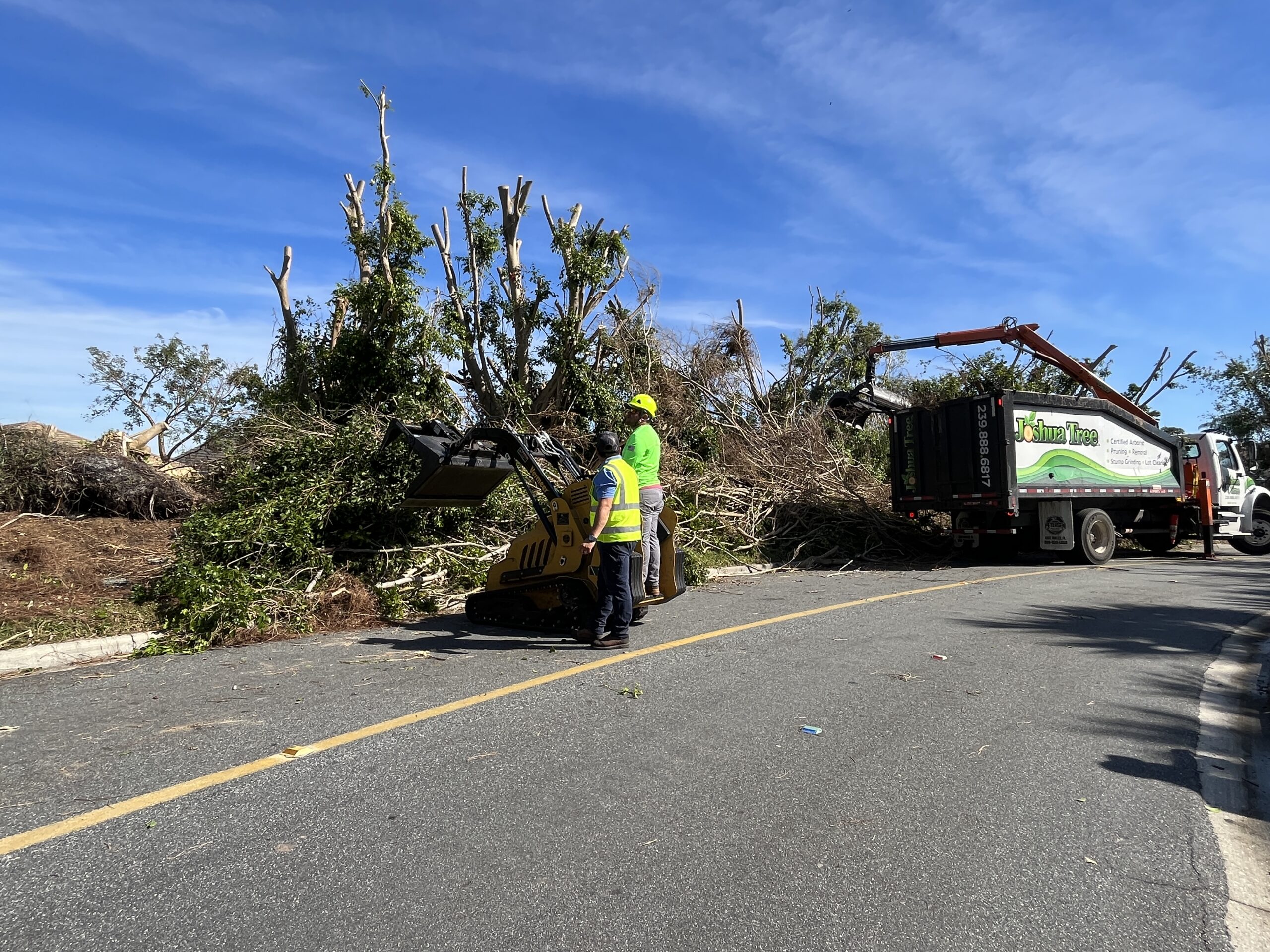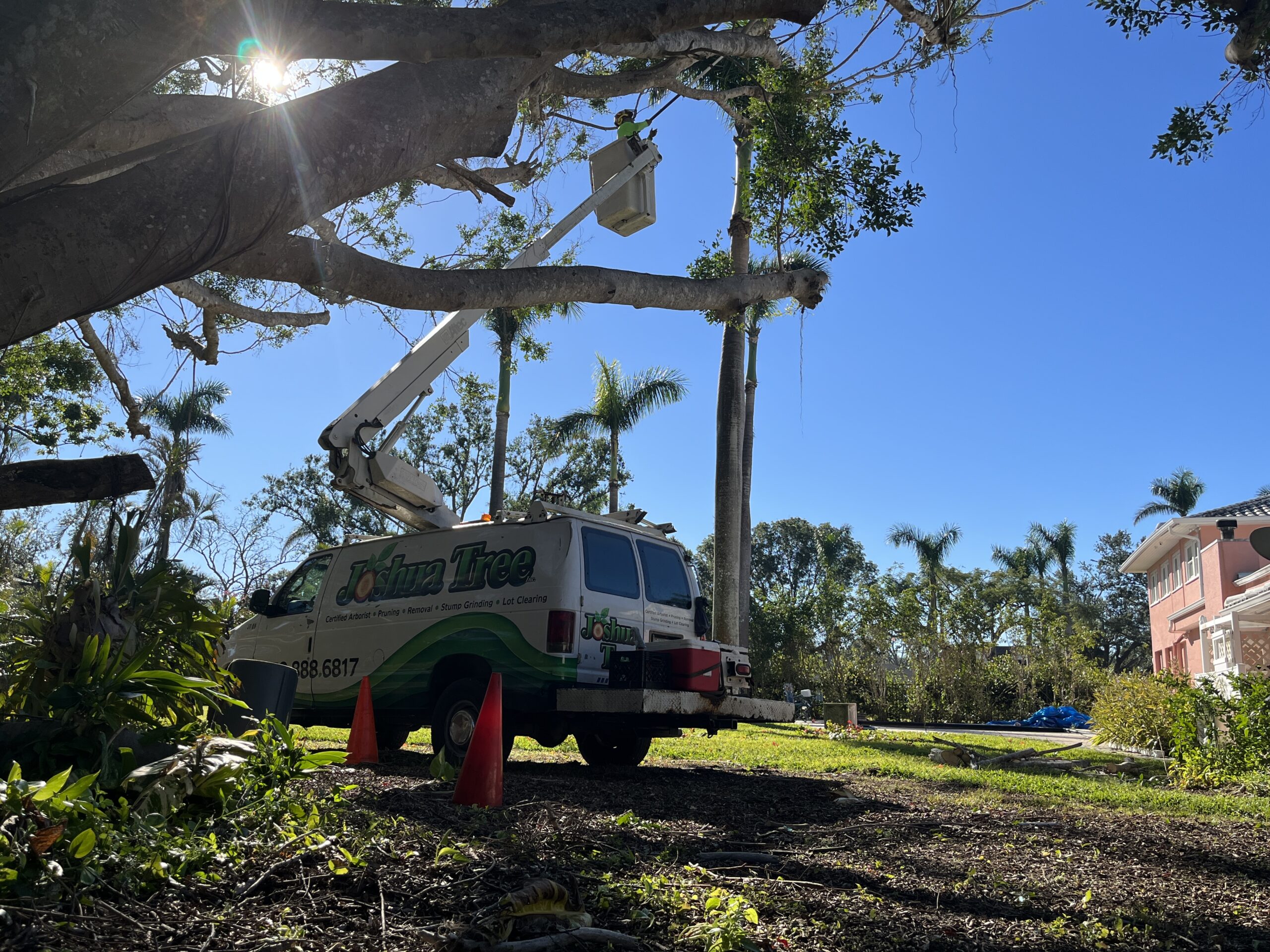
With Florida in the midst of hurricane season, many homeowners are wondering how to take care of the trees on their property. How do you know whether your palm or pine trees require removal? What if there’s still hope left for them to recover after hurricane damage? Some of the other pertinent questions include the following: Should you proceed with clearing debris yourself, or do you need to contact an ISA-certified arborist?
At Joshua Tree Inc., we decided to give you a comprehensive overview of the steps you should take after a hurricane to take care of your safety as well as your trees.
General Guidelines on How to Take Care of Your Trees
To begin with, let’s take a look at some common signs that help differentiate between trees that need to be removed and those that have a chance to recover.
Trees with substantial cracks along major limbs or the trunk are potential hazards and should be promptly removed. Similarly, trees with exposed or uplifted roots often indicate compromised stability and require removal.
On the other hand, trees with defoliated canopies and broken small branches can often recuperate with proper attention. For younger trees that have leaned due to the storm, replanting might be a great option.
If you have palm or pine trees on your property, there might be some additional considerations to keep in mind when deciding what to do with these tree species after a hurricane.
Guidelines for Pine Trees
Damage caused to pine trees by a hurricane might not be visible. Sometimes strong winds cause ruptures inside a tree’s trunk or roots, which hinder the tree’s ability to sufficiently supply nutrients to its branches. Before deciding whether to remove a pine tree or not, it’s often necessary to allow several months of observation. Pine trees displaying entirely brown needles should be considered for removal.
Guidelines for Palm Trees
Post-storm care for palm trees comes with its own set of considerations. Palms with snapped trunks or damaged bud growth are unlikely to rebound and should be promptly removed.
When caring for a palm tree after a hurricane, follow these guidelines:
Pruning Damaged Fronds
Begin by pruning any broken or dead fronds. Use clean and sharp pruning shears to make clean cuts. Removing damaged fronds will not only improve the tree’s appearance but also prevent disease and fungal infections from spreading.
What to Do with Bent Fronds
If the palm tree has fronds that are partially broken but still attached, leave them until new fronds fully emerge. This will help the tree conserve energy and direct resources to new growth.
Supporting Upright Growth
If the palm tree’s trunk has been bent or knocked over, it may need to be supported to encourage upright growth. Use stakes or braces to gently guide the trunk back to its upright position. Be careful not to cause further damage to the roots.
Providing Adequate Water and Nutrition
After a hurricane, it’s essential to ensure that the palm tree receives proper hydration. Water the tree’s root zone deeply and regularly, especially if there’s a drought or dry conditions. However, avoid overwatering, as waterlogged soil can lead to root rot. A general guideline is to irrigate your recovering palm tree three times a week for six weeks.
Remember that patience is the key when it comes to palm trees. It might take a couple of years before they restore their canopy in full.
How to Remove a Tree
If you need to remove a fallen tree, ensuring safety during the removal process takes precedence. Here’s a step-by-step guide:
- Establish a Safe Zone: The first task is to establish a secure perimeter around the tree to prevent access during the removal process.
- Chainsaw Utilization: If you’re confident in handling a chainsaw, make certain the blade is sharp, as dull blades can lead to accidents.
- Electrical Hazard Assessment: Before proceeding, carefully inspect the area for any downed power lines or other electrical hazards. If you identify any risks, promptly notify your local utility company.
- Professional Involvement: While chainsaw use on the ground may be manageable for homeowners, situations that involve climbing or cutting near utility lines should be left to ISA-certified arborists.

How to Prune a Tree
Pruning damaged trees demands a meticulous approach to promote their recovery:
- Eliminating Dead Branches: Remove sizeable dead branches and broken limbs, both for safety reasons and to aid in the tree’s recovery.
- Varieties of Cuts: Three primary cut types come into play—removal cuts, reduction cuts, and heading cuts. Removal cuts involve the complete removal of a branch or limb from the tree. Reduction cuts are used for selectively trimming a branch’s length to reduce its overall size. Heading cuts involve trimming the tips of branches to promote new growth and shape the tree.
- Managing New Growth: On trees that are recuperating, managing new sprouts is essential to reinstating the tree’s structure. Prune unwanted sprouts to encourage robust regrowth.
Hiring a Trusted Arborist
If you decide that you want to entrust tree care to an arborist, how do you choose a professional you can trust? Consider the following points:
- Insurance Coverage: Before proceeding, double-check that the arborist carries comprehensive insurance coverage. This safeguards you against potential liabilities stemming from any accidents during the job.
- Validating Certification: Request verifiable proof of certification from the International Society of Arboriculture (ISA). This validation underscores the arborist’s proficiency and commitment to industry standards.
- Multiple Estimates: It’s wise to gather estimates from several arborists, ensuring that you’re receiving competitive pricing for the necessary services.
In the wake of a storm’s havoc, the road to recovery for your trees demands expertise, precision, and a deep understanding of arboriculture. This is precisely where Joshua Tree Inc. steps in as your trusted partner in restoring the vitality and safety of your storm-damaged trees in Florida. You can trust that our arborists are fully insured and certified by the ISA, providing you with peace of mind as we work to bring your storm-damaged trees back to life. Contact us today for an estimate!
